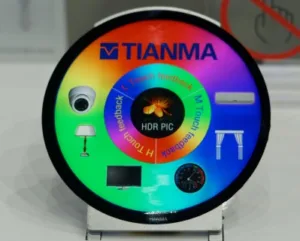Tianma had its usual long list of developments in a range of different industrial and specialist applications.
The first product that we looked at was a circular display designed for automotive and other instrumentation systems and has outline dimensions of 133 x 133mm and is 2.1mm thick. Resolution is 1080 x 1080 and contrast is 100,000:1 because the module has miniLEDs in the direct backlight, although the number of zones was not stated. The unit has touch that works with wet fingers and gloves as well as supporting haptic touch feedback.
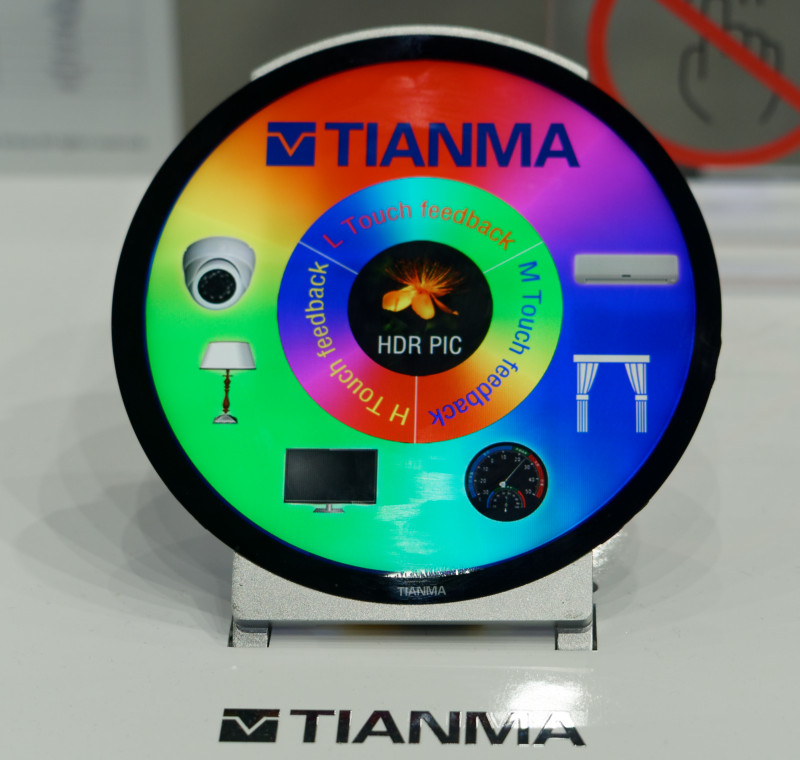 The Tianma circular display includes touch feedback and uses miniLEDs for high contrast. Image:Meko
The Tianma circular display includes touch feedback and uses miniLEDs for high contrast. Image:Meko
Privacy filters are becoming more and more important in the market and Tianma has a switchable ‘Active Louver Technology’ (ALT) that allows a change from a private mode to a public mode for different purposes. Few details were available, but the company told us that there are applications in POS and that the technology is ‘ink-based’. The ALT mode was shown as a “technology demo” and the company was looking for feedback on the commercial possibilities.
 The Tianma ALT mode allows switchable privacy modes. Image:Meko
The Tianma ALT mode allows switchable privacy modes. Image:Meko
The next demo was of a 4:3 2048 x 1536 panel based on the SFT IPS-like technology that is for medical, broadcast and gaming. It has 500 cd/m² of output and 1,400:1 contrast. The colour support is 120% of NTSC/90% of Rec 2020/99% DCI-P3/100% AdobeRGB, using non-cadmium quantum dot technology combined with an optimised colour filter. The display looked good to us.
The company also had a 21.3″ sample display using the company’s FFS variation that has 2,000:1 contrast ratio and is being developed for use in medical displays. We think that is the first time we’ve seen an IPS-like panel with 2,000:1 contrast.
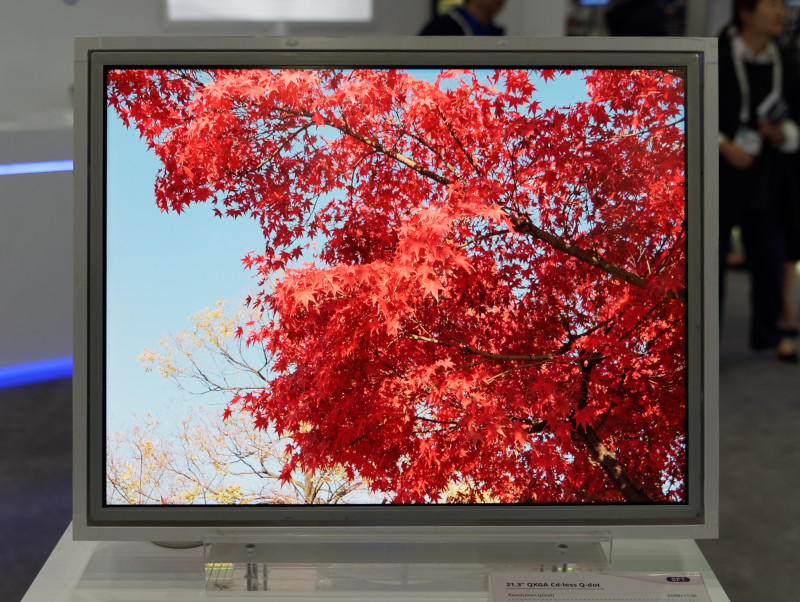 This 3 megapixel LCD uses QDs for wide colour gamut support. Image:Meko
This 3 megapixel LCD uses QDs for wide colour gamut support. Image:Meko
Next we turned to smaller displays and the first we looked at was a 1.2″ reflective circular display for hybrid smartwatches. The display has an ultra-small hole in the middle for a mechanical watch mechanism. Also shown was a 4.4″ transflective display using a 640 x 480 resolution with 25.2% reflectance and 9.7:1 contrast. Colour support is 22.4% of NTSC and the unit is designed for outdoors applications including industrial use and GPS and has good sunlight readability.
Another display that is suitable for high ambient was an 11.6″ FullHD LCD with 1,400 cd/m² of output and 900:1 contrast and based on IPS technology for marine, aviation and rugged applications. The company also has a 10.1″ 1280 x 800 LCD with 1,000 cd/m² of output that is rated to survive 7.0G vibration in applications such as construction and agriculture instrumentation.
This kind of application also needs robust touch sensing and Tianma was showing an 11.6″ PCap FullHF display with 430 cd/m² and 1,000:1 contrast that uses optical bonding and can support wet finger and glove-based touch sensing. The firm expects to see applications in medical environments.
Also in this area was a 5″ 1,000 cd/m² display that has wide temperature support from -30 deg C to +85 deg C and expected to be used in motorcycle applications.
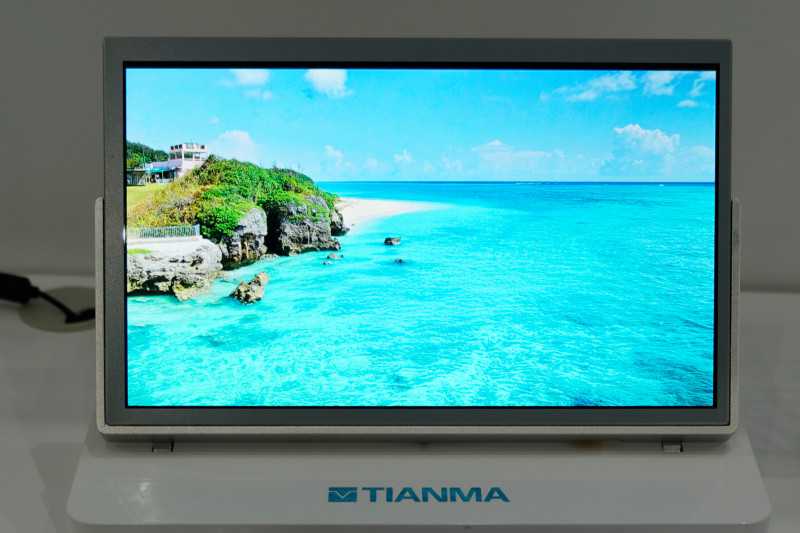 This 11.6″ display is for marine, aviation and other applications in bright light. Image:Meko
This 11.6″ display is for marine, aviation and other applications in bright light. Image:Meko
Optical bonding was also being used on a 27″ UltraHD panel that is intended for medical use. The panel has 780 cd/m² of output and 1,000:1 contrast while supporting 90% of the NTSC colour gamut.
A second 27″ UltraHD panel with the same colour and contrast and 800 cd/m² output is very slim at 6.4mm and also intended for medical applications. Another thin module was an 11.6″ FullHD panel that has 450 cd/m² of output and 70% of NTSC with 1,000:1 contrast and is just 3.3 mm thick. Tianma expects the panel to be used for in-flight-entertainment, where the thickness is a real advantage.
 This 27″ UltraHD panel is just 6.4mm thick and intended for medical applications. Image:Meko
This 27″ UltraHD panel is just 6.4mm thick and intended for medical applications. Image:Meko
Turning to smaller panels, we looked at a new 6.2″ ‘free-form’ LCD with a 1.8mm bottom border (0.6mm on the sides and top) that has an integrated TM TED touch sensor integrated under the display or can be supplied with a bottom notch for a discrete fingerprint detector. Resolution is 1080 x 2400 (423ppi) and luminance is 480 cd/m² with contrast of 1,600:1.
There was also a 2.8″ LTPS display with 800 ppi for VR applications.
Moving forward, Tianma, along with others at the show, expects a move away from top ‘notches’ to small camera holes in the display next year. A second 6.2″ 1080 x 2400 prototype was shown. It has a 2.25mm radius hole with a 0.75mm border. Colour gamut is 96% of NTSC
 A big trend for next year may be the use of smartphone displays with camera holes (top left) rather than notches. Image:Meko
A big trend for next year may be the use of smartphone displays with camera holes (top left) rather than notches. Image:Meko
At the show, Tianma won an award for its HDR WQHD 6.46″ LCD (498ppi) which has peak brightness of more than 1000 cd/m² by using miniLED backlights and a high purity colour filter. The grey scaling is 10 bit and the colour gamut is in line with DCI-P3, while dynamic contrast is more than 20,000:1 . The company hopes to be in mass production by the end of 2019.
 This HDR display for smartphones won a Best in Show award at Display Week. Image:Meko
This HDR display for smartphones won a Best in Show award at Display Week. Image:Meko
Tianma is looking for a range of solutions for expanding colour gamut and as well as QDs which can get to 125% of NTSC/92% of Rec 2020, 100% of AdobeRGB and 96% of DCI-P3, the company has a new LED backlight which, when matched with optimised colour filters, can get to 110% of NTSC/ 100% of AdobeRGB and 98% of DCI-P3.
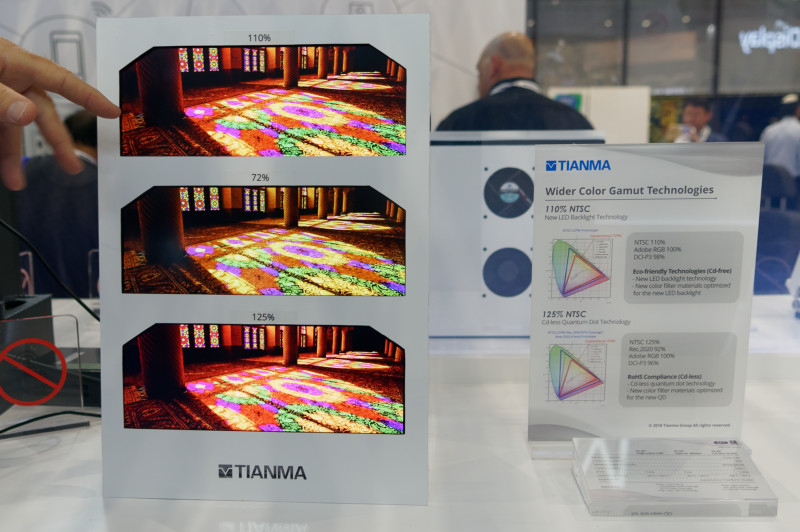 Tianma is looking at improved LEDs as well as QDs for WCG solutions. Image:Meko
Tianma is looking at improved LEDs as well as QDs for WCG solutions. Image:Meko
Automotive is an important growth market and the company was showing a mock-up of a cockpit with a wide display and also with displays to replace the side mirrors. The company sees LTPS as an important technology to meet the requirements of auto makers, who also like local dimming to reduce the black level as much as possible, to achieve the look of OLED, without the qualification challenges. Native contrast is around 2,000:1 for the 12.3″ panel shown (which has 96 zones), with 135,000:1 available in dynamic mode as peak brightness is 2,500 cd/m², with 600 cd/m² in all white mode. Operating temparature range is -40º C to + 85º C. Colour support is
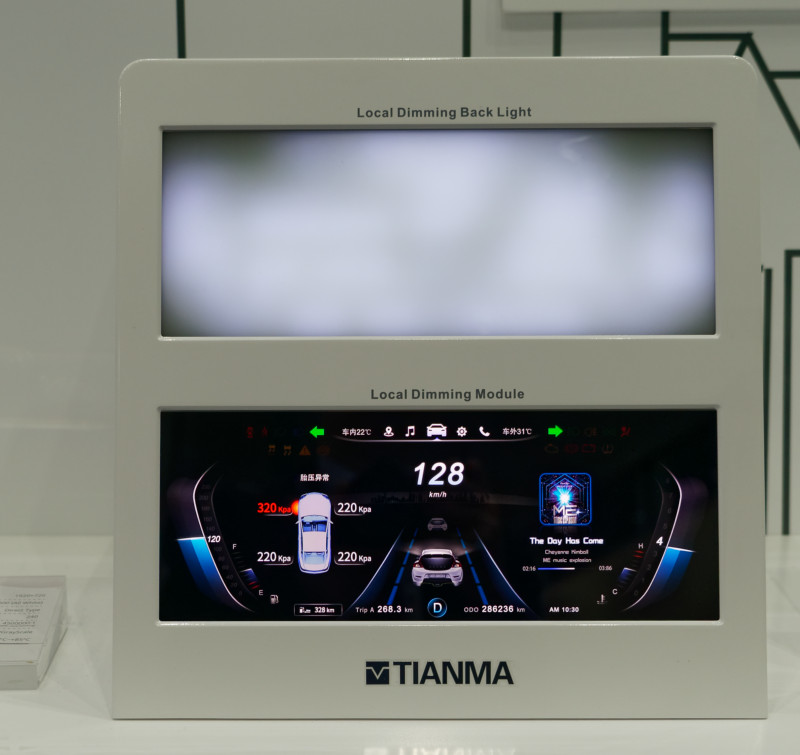 This 12.3″ module uses LTPS and local dimming to achieve borders of 4/4/4/11mm. Image:Meko
This 12.3″ module uses LTPS and local dimming to achieve borders of 4/4/4/11mm. Image:Meko
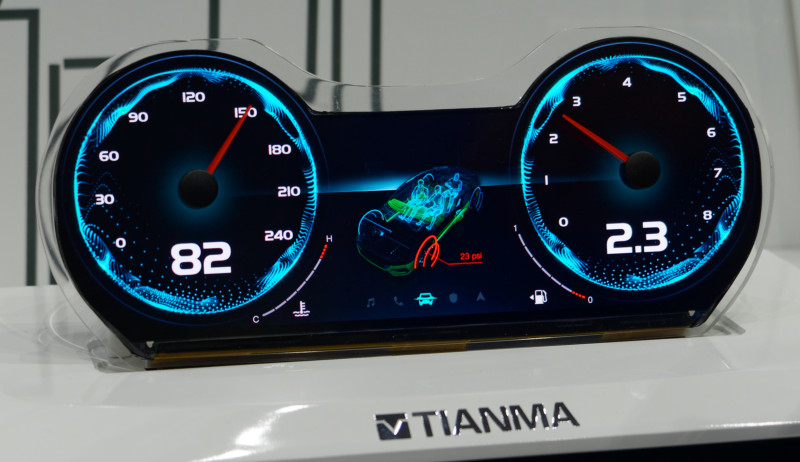 This 12.3″ Free form module has holes to allow the integration of mechanical meter needles as well as LCD displays. The display can have a 1.1mm border. Image:Meko
This 12.3″ Free form module has holes to allow the integration of mechanical meter needles as well as LCD displays. The display can have a 1.1mm border. Image:Meko
Tianma is also developing OLED displays and was showing a 5.99″ 1440 x 2880 OLED with 500 cd/m² of output and 100,000:1 contrast. The display can sense force touch using in-cell piezoresistive technology (TED Plus). There was also a foldable OLED that can sense via an integrated strain sensor when it is being folded, twisted or rolled and makes the device ideal for wearables, Tianma believes.
The company also had a 4.2″ AMOLED for automotive applications.
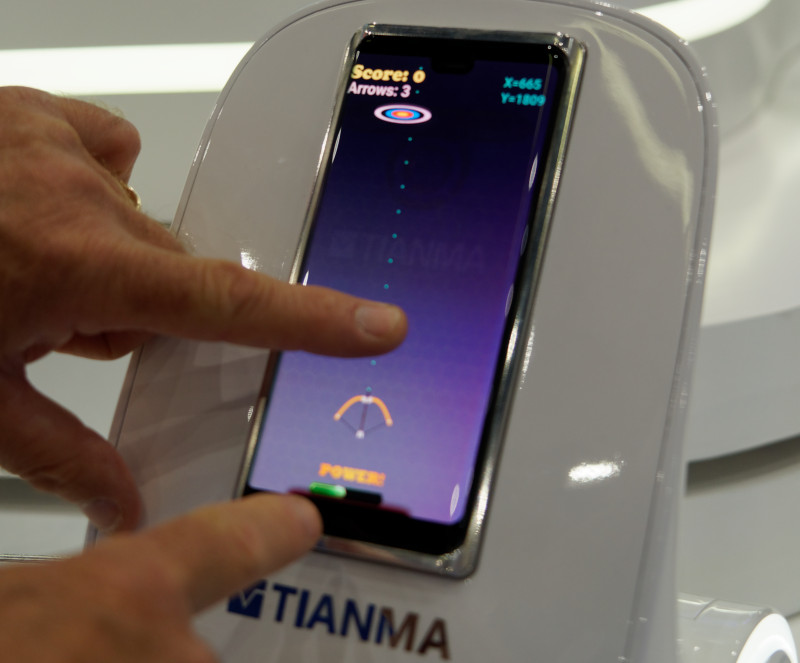 This 5.99″ OLED can sense force using integrated sensors. Image:Meko
This 5.99″ OLED can sense force using integrated sensors. Image:Meko
There was a flexible 2880 x 1440 AMOLED that has side borders of 0.9mm and a bottom border of 2.0mm and that can be folded inward to a radius of 3mm. The display is just 0.2mm thick and has 100,000:1 contrast and 350 cd/m² of output.
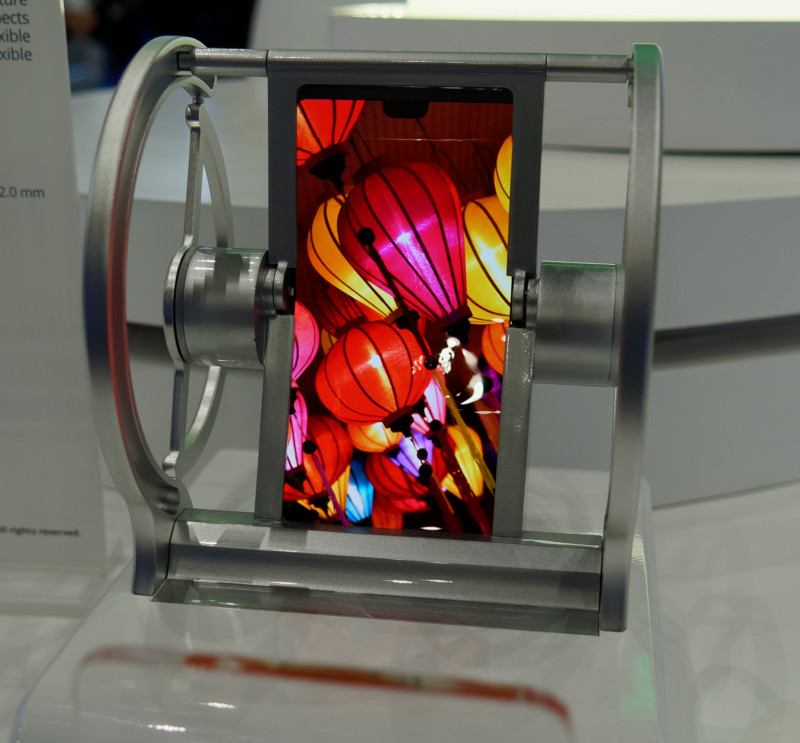 This flexible OLED is just 0.2mm thick. Image:Meko
This flexible OLED is just 0.2mm thick. Image:Meko
Analyst Comment
There was also a display using touch and gesture recognition, for POS applications, but our notes were unclear, so we have reached out to the company for clarification at press time. Image:Meko

